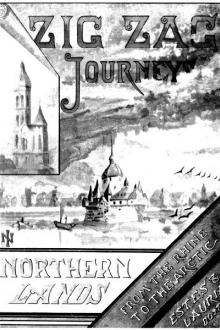Zigzag Journeys in Northern Lands by Hezekiah Butterworth (fiction books to read .txt) 📕

- Author: Hezekiah Butterworth
- Performer: -
Book online «Zigzag Journeys in Northern Lands by Hezekiah Butterworth (fiction books to read .txt) 📕». Author Hezekiah Butterworth
“Weimar is a quaint provincial-looking town on the river Ilm. It has some sixteen thousand inhabitants, and is the residence of the Grand Duke of Saxe-Weimar. The grounds of the palace are wonderfully beautiful. They extend along the river, and communicate with a summer palace called Belvedere.
“We visited the tombs of the two great poets. They are found beneath a small chapel in the Grand Ducal burial vault. The Grand Duke Charles Augustus desired that the bodies of the two poets should be interred one on each side of him: but this was forbidden by the usages of the court.
“In the old Stadtkirche, built in 1400, are the tombs of the ancient dukes, now forgotten. Among them is that of Duke Bernard, who died in 1639. He was the friend of Gustavus Adolphus, and one of the most powerful of the leaders of the Reformation.
“Goethe, the most gifted of the German poets, and the most accomplished man of his age, was born at Frankfort-on-the-Main, in 1749. In 1775 he made the intimate acquaintance of Charles Augustus, Grand Duke of Saxe-Weimar, who induced him to take up his residence at Weimar, the capital. Here he held many public offices, and at last became minister of state. He died at the age of eighty-four.
“Goethe’s most popular work is a novel called The Sorrows of Werther, but his great and enduring work is Faust, a dramatic poem, in which his great genius struggles with the problems of good and evil.
“His life was full of beautiful friendships. In 1787 Schiller, the second in rank of great German poets, was invited to reside at Weimar. Goethe became most warmly attached to him, and the two pursued their high literary callings together. The literary circle now consisted of Goethe, Schiller, Wieland, Herder, and the Grand Duke. It was the golden age of German literature.
THE STRANGE STORY OF FAUST.No myth of the Middle Ages has had so large a growth and so long a life as this.
It has been made the subject of books, pamphlets, and articles almost without number. The Faust literature in Germany would fill a library.
In painting, especially of the Holland school, the dark subject as prominently appears. It is also embodied in sculpture.
But it is in poetry and music that it found a place that carried it over the world. It was made the subject of Marlowe’s drama, of Goethe’s greatest poem, and it is sung in three of the greatest operas of modern times.
But to the legend.
About the year 1490 there was born at Roda, in the Duchy of Saxe-Weimar, a child whose fame was destined to fill the world of superstition, fable, and song. He was named John Faustus, or Faust.
He studied medicine, became an alchemist, and was possessed with a consuming desire to learn the secrets of life and of the spiritual world.
He studied magic, and his thirst for knowledge of the occult sciences grew. He wished to know how to prolong life, to change base metals to gold, to do things at once by the power of the will.
One night, as he was studying, the Evil One appeared before him.
“I will reveal to you all the secrets you are seeking, and will enable you to do anything you wish by the power of the will alone—”
Dr. Faustus was filled with an almost insane delight.
“—On one condition.”
“Name it.”
“That I shall have your soul in return.”
“When?”
“At the end of twenty-four years—at this time of night—midnight.”
“I shall have pleasure?”
FAUST SIGNING.
“Pleasure.”
“Gold?”
“Gold.”
“I shall know the secrets of nature?”
“The secrets of nature.”
“I may do what I like at will?”
“At will.”
“I will sign the compact.”
“Sign!”
Faust signed his name to a compact that was to give the Evil One his soul for twenty-four years of pleasure, gold, and knowledge, that were to come to an end at midnight.
“I will give you an attendant,” said the Evil One, “to help you.”
He caused a dark but very elegant gentleman to appear, whom he presented to Faust as Mephistopheles.
Dr. Faustus and Mephistopheles now began to travel into all lands, performing wonders to the amazement of all people wherever they went.
In a wine-cellar at Leipsig, where he and Mephistopheles were drinking, some gay fellows said,—
“Faust, make grapes grow on a vine on this table.”
“Be silent.”
There was dead silence.
FAUST AND MEPHISTOPHELES.
A vine began to grow from the table, and presently it bore a bunch of grapes for each of the revellers.
“Take your knives and cut a cluster for each.”
There was an explosion. Faust and Mephistopheles were seen flying out of the window; the window is still shown in Leipsig. The vine had disappeared, and each of the revellers found himself with his knife over his nose, about to cut it off, supposing it to be a cluster of grapes.
The wonders that it is claimed that Dr. Faustus did in the twenty-four years fill volumes. The Faust marvels have gathered to themselves the fables of centuries.
The twenty-four years came to an end at last. Faust became gloomy, and retired to Rimlich, at the inn, among his old friends.
The fatal night came.
“Should you hear noises in my chamber to-night, do not disturb me,” he said, on parting from his companions to go to his room.
Near midnight a tempest arose,—a wild, strange tempest. The winds were like demons. It thundered and the air was full of tongues of lightning.
At midnight there was heard a fearful shriek in Faust’s chamber.
The next morning the room was found bespattered with blood, and the body of Faust was missing. The broken remains of the alchemist were discovered at last in a back yard on a heap of earth.
This was the village story. It grew as such a dark myth would grow in the superstitious times in which it started. Goethe created the character of Marguerite and added it to the fable. The transformation of Faust from extreme old age to youth was also added. The opera makers have greatly enlarged even the narrative of Goethe; in the latest evolution, Mephistopheles is summoned into the courts of heaven and sent forth to tempt Faust, and Faust is shown visions of the Greek vale of Tempe and Helen of Troy.
Faust has come to be a synonym of the great problem of Good and Evil; the contest between virtue and vice, temptation and ruin, temptation and moral triumph. It is not a good story in any of its evolutions, but it is one that to know is almost essential to intelligence.
“Returning to Coblentz, we passed our sixth night on the Rhine. We there hired a boatman to take us to Bonn. Between Coblentz and Andernach we passed what are termed the Rhine Plains. These are some ten miles long, and are semicircled by volcanic mountains, whose fires have long been dead.
“We now approached the Seven Mountains, among which is the Drachenfels, famous in fable and song. These are called: Lohrberg, 1,355 feet; Neiderstromberg, 1,066 feet; Oelberg, 1,429 feet; Wolkenberg, 1,001 feet; Drachenfels, 1,056 feet; Petenberg, 1,030 feet; Lowenberg, 1,414 feet.
“The Drachenfels is made picturesque by an ancient ruin, and it is these ancient ruins, and associations of old history, that make the Rhine the most interesting river in the world. Apart from its castles and traditions, it is not more beautiful than the Hudson, the Upper Ohio, or the Mississippi between St. Paul and Winona. But the Rhine displays the ruined arts of two thousand years.
“The Drachenfels has its wonderful story. It is said that Siegfried killed the Dragon there. The so-called Dragon Cave or Rock is there, and of this particular dragon many curious tales are told.
“In the early days of Christianity the cross was regarded as something more than a mere emblem of faith. It was believed to possess miracle-working power.
“In a rocky cavern of the Drachenfels, in ancient times, there lived a Dragon of most hideous form. He had a hundred teeth, and his head was so large that he could swallow several victims at a time. His body was of enormous length, and in form like an alligator’s, and he had a tail like a serpent.
“The pagans of the Rhine worshipped this monster and offered to him human sacrifices.
“In one of the old wars between rival princes, a Christian girl was taken captive, and the pagan priest commanded that she should be made an offering to the Dragon.
“It was the custom of the pagans to bind their sacrifices to the Dragon alive to a tree near his cave at night. At sunrise he would come out and devour them.
“They led the lovely Christian maiden to a spot near the cave, and bound her to a tree.
“It was starlight. Priests and warriors with torches had conducted the maiden to the fatal spot, and stood at a little distance from the victim, waiting for the sunrise.
A CLEFT IN THE MOUNTAINS.
“The priests chanted their wild hymns, and the light at last began to break and to crown the mountains and be scattered over the blue river.
“The roar of the monster was heard. The rocks trembled, and he appeared. He approached the maiden, bound to an oak.
“Her eyes were raised in prayer towards heaven.
“As the Dragon approached the victim, she drew from her bosom a crucifix, and held it up before him.
“As soon as he saw it, he began to tremble. He fell to the earth as if smitten. He lost all power and rolled down the rocks, a shapeless mass, into the Rhine.
“The pagans released the girl.
“‘By what power have you done this?’ they asked.
“‘By this,’ said the maiden, stretching out the cross in her hand. ‘I am a Christian.’
“‘Then we will become Christians,’ said the pagans, and they led the lovely apostle away to be their teacher. Her first convert was one of the rival princes, whom she married. Their descendants were among the most eminent of the early Christian families of the Seven Mountains of the Rhine.
“Such is the fable as told by the monks of old. The figure of the power of the cross over the serpent, employed in early Christian writings, undoubtedly was its origin, but how it became associated with the story of the captive maiden it would be hard to tell.”
Master Lewis introduced the story-telling of the evening by anecdote pictures of
FREDERICK THE GREAT.Frederick the Great, King of Prussia, was born in 1712. He was a wilful youth, and his father subjected him to such severe discipline that he revolted against it, and, like other boys not of royal blood, formed a plan of running away from home. His father discovered the plot, and caused his son’s most intimate friend, who had assisted him in it, to be put to death, and made the execution as terrible as possible. He early came to hate his father, his father’s religion, and everything that the old king most liked. His father was indeed a hard, stern man, of colorless character; but he managed the affairs of state so prudently that he left his undutiful son a powerful army and a full treasury, and to these as much as to any noble qualities of mind or soul the latter owed the resources by which he gained the title





Comments (0)